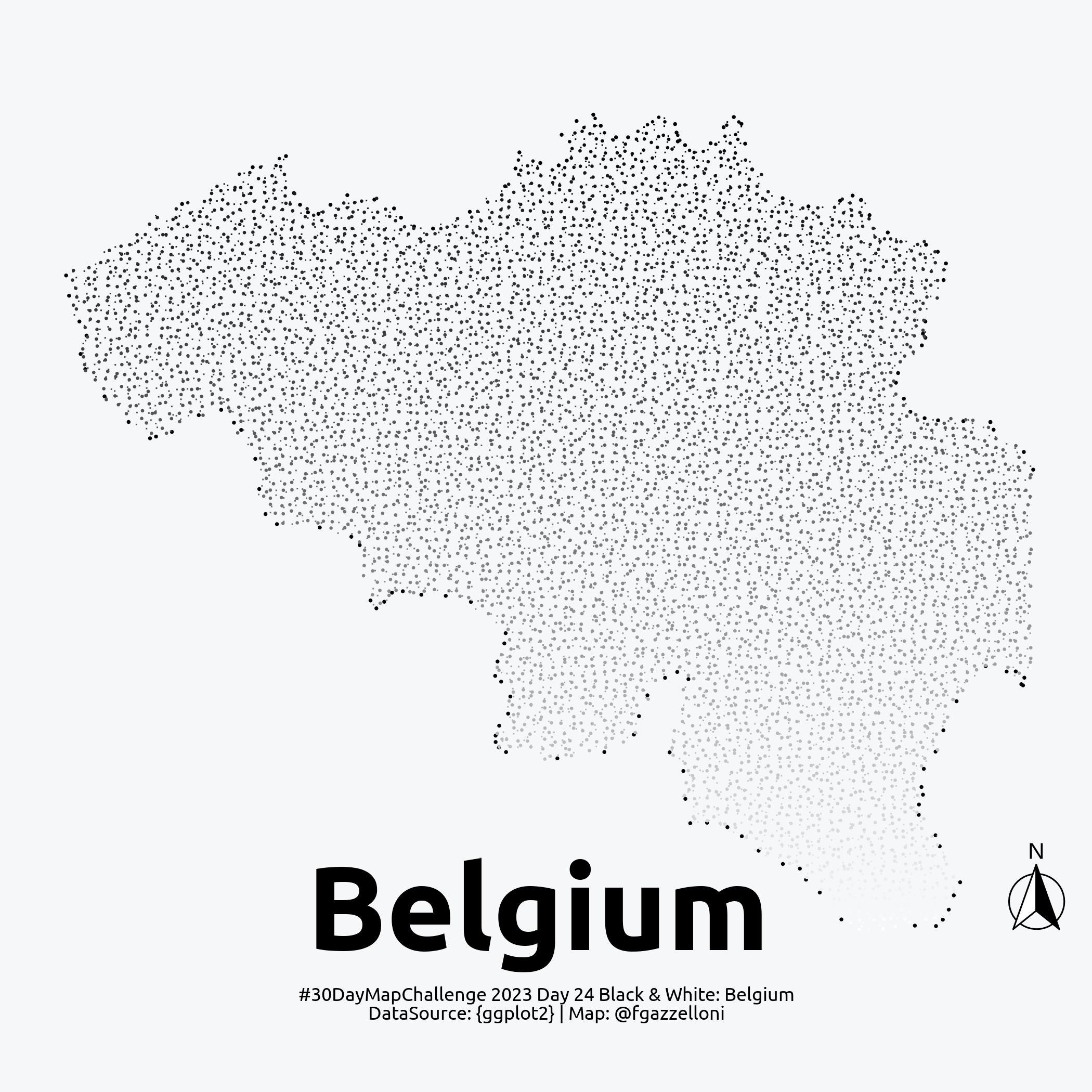library(tidyverse)
library(sf)
library(ggspatial)Overview
This Black & white Belgium Map is build creating a grid of points.

Load necessary libraries
library(showtext)
library(sysfonts)library(maps)
library(DescTools)font_add_google(name = "Ubuntu", family = "Ubuntu")
showtext_auto()
showtext_opts(dpi = 320)Load the Belgium boundaries with map_data() function from the {ggplot2} package.
world <- map_data('world')
belgium<- world%>%
filter(str_detect(region,"Belgium"))Transform the Belgium dataset containing the longitude and latitude into a simple feature object with the st_as_sf() function from the {sf} package, and visualize the polygon. In this case is a POINT polygon.
bg_sf <- belgium%>%
st_as_sf(coords = c("long","lat"))%>%
st_make_valid()ggplot(bg_sf)+
geom_sf(color="grey40")+
coord_sf()+
theme_bw()Let’s have a look at the same map witout transofrmation.
ggplot(belgium)+
geom_polygon(aes(long,lat,group=group),fill="grey40")+
coord_sf()+
theme_bw()In order to make a full grid of the Belgium polygon, the boundary box is extracted from the simple feature object with the st_bbox() function from the {sf} package.
bg_bbox <- bg_sf%>%
st_bbox()
bg_bboxLet’s first have a look at a simple perimeter grid with sf::st_make_grid() function, specifying the type of grid options, square = FALSE, and cellsize = .1.
grid <- bg_sf%>%
sf::st_make_grid(square = FALSE,cellsize = .1)Visualize the grid:
ggplot()+
geom_sf(data=grid)+
geom_sf(data=bg_sf)+
coord_sf()+
theme_bw()min_lon <- bg_bbox[1]
max_lon <- bg_bbox[3]
min_lat <- bg_bbox[2]
max_lat <- bg_bbox[4]And calculate the full grid of points:
bg_grid <- expand_grid(x = seq(from = min_lon,
to = max_lon, length.out = 100),
y = seq(from = min_lat,
to = max_lat, length.out = 100))bg_coords <- belgium %>%
select(1:2) %>%
rename(x = long, y = lat)In this case the application of the DescTools::PtInPoly() function builds points within the boundaries of a given polygon. The point in polygon, pip vector is created. The algorithm implements a sum of the angles made between the test point and each pair of points making up the polygon.
bg_grid_map <- data.frame(DescTools::PtInPoly(bg_grid, bg_coords)) %>%
filter(pip == 1) %>%
# group by latitude
group_by(y) %>%
# set a new id vector for grouping points
mutate(id = dplyr::cur_group_id()) %>%
ungroup()Make the map:
ggplot() +
geom_jitter(data=belgium,
aes(long,lat,group=group),size=0.2)+
geom_jitter(data = bg_grid_map,
aes(x, y, group = id,color=y),
size=0.1,show.legend = F)+
geom_jitter(data = bg_grid_map,
aes(x, y, group = id,color=y),
shape=".",show.legend = F) +
scale_color_gradient(low = "white",high = "black") +
scale_y_continuous(limits = c(49.5294835476, 51.4750237087)) +
scale_x_continuous(limits = c(2.51357303225, 6.15665815596)) +
coord_map(clip = "off") +
annotate("text", y = 49.68, x = 4.3,
label = "Belgium",
family="Ubuntu",
fontface = "bold",
size = 18, color = "#000000", vjust = "top") +
ggspatial::annotation_north_arrow(location = "br",
which_north = "true",
pad_x = unit(0.0, "in"),
pad_y = unit(0.2, "in"),
style = north_arrow_fancy_orienteering)+
labs(caption = "#30DayMapChallenge 2023 Day 24 Black & White: Belgium\nDataSource: {ggplot2} | Map: @fgazzelloni")+
ggthemes::theme_map() +
theme(text = element_text(family="Ubuntu"),
plot.caption = element_text( hjust = 0.5,
vjust=-0.1,
size = 8),
plot.caption.position = "plot")ggsave("day_24_black&white.png",bg="#f6f7f9")